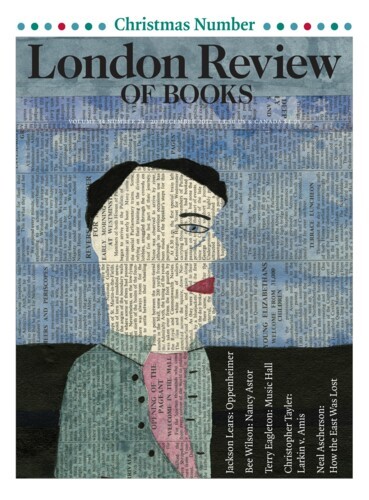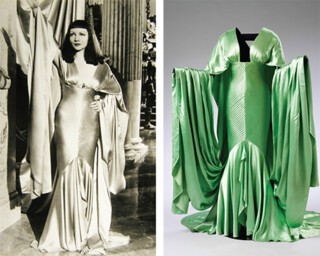Dressmakers’ dummies are favourites with photographers of haunting; Eugène Atget, who rarely shows the inhabitants of a Parisian street or room, dwells on the smiling mannequins in shop windows, wearing aprons and housemaids’ caps, or on an effigy of madame in a string of pearls and a tilted trilby. Fixed expressions and rigid bodies give the images an uncanny aura – something similar radiates from cult statues when they’re dressed up and carried in procession in Spain or Italy. The idol looks trapped in a perpetual no-man’s-land, and the feeling around them turns somnambulist, peculiar and unreal. Hollywood Costume (at the V&A until 27 January 2013) establishes a similar otherworld where ghosts have gathered, even though many of the subjects are still with us. Wearing the costumes they wore for famous roles overlays their living presence with the spectral shimmer of their apparitions on screen. These figments, as Andy Warhol called his famous persona, are mingling, too, with many who are long dead. Ronald Reagan and Meryl Streep, Bette Davis and Robert De Niro jostle closely together in several large spaces, chambers for different sins in the afterlife – for vamping, sharp-shooting, taxi-driving – while a flickering crowd comes and goes in an endless loop on screens and monitors. The stars have been cybernetically generated to appear among us again, like the phantoms who materialise at the tug of the tides in Adolfo Bioy Casares’s visionary fable about perpetual beauty, ‘The Invention of Morel’ (1940).
This strenuous animation, by the design team Casson Mann, tries to overcome the atmosphere of a waxworks museum. Christopher Frayling, the ‘guest curator’, writes a museological piece in the catalogue, a luxurious and mighty tome, about the tricky history of costume display and changing styles in mannequins and lighting. Here, the dummies have two-way scrims for heads, on which footage of the actor who wore the outfit is beamed up translucently (making it visible from back and front) and the whole show unfolds to a vast background score as if the exhibition were a sweeping drama or even a thriller. (I thought I was failing to identify the film, as it sounded so familiar, but it turns out the music was specially commissioned, from Julian Scott.) Montages of film clips play throughout on further screens, concocting essence of Hollywood in several flavours: romance, western, fantasy, history, sci-fi, thriller, noir. But the same costumes look very different on screen; the face, the gestures, and above all the gait of the stars give them life, which no amount of digital ingenuity can do.
The chief curator, Deborah Nadoolman Landis, is herself a celebrated Hollywood designer (Raiders of the Lost Ark; Michael Jackson’s Thriller) and now a professor of design history at UCLA; the show consists of some pieces of her own, and many others from Debbie Reynolds’s collection, recently sold – she had pioneered salvaging costumes from studio wardrobes. Landis has set out the rooms to argue for the unsung importance of costume; the show puts forward detailed insider knowledge, with four veteran Hollywood designers – all of them women – specially featured: Edith Head (d. 1981), for example, who worked with Hitchcock, is responsible for that neat-as-a-pin look that does so much to sharpen fears of being messed up. A strong new interest in process, craftsmanship and behind the scenes struggles inspires insights and anecdotes from the trade, and these enliven the gloaming and sombre galleries of ghosts. ‘I don’t dress movie stars. I dress actors who are playing characters,’ Ann Roth declares. She has worked closely with Meryl Streep, and adds that, together, ‘we wait for the third person to arrive.’ Streep, we know, is one of the screen’s most skilled chameleons, and the show makes its case for the importance of the look, with vignettes that run from The French Lieutenant’s Woman to The Devil Wore Prada to The Iron Lady. ‘You have to work doubly hard to make contemporary clothes disappear,’ another designer says, while Marit Allen, who worked on Brokeback Mountain, underlines the ‘subliminal telegraphy’ that clothes give out, adding the mysterious information that ‘polyester has a sexual connotation.’ Adrian (d. 1959; The Wizard of Oz, Marie Antoinette and dozens of other classics), was a master optical illusionist, going for textures that gleam and coruscate under the studio lights and contrasts that turn the screen into kinetic art. The camera, he said, is ‘more calculating than the human eye’, and in the era before Technicolor emphasised the need to select for shades, not hues, to compose graphic scenes while at the same time giving actors colour to respond to. The Vaseline that glamour photographers like George Hurrell smeared on the lens to add soft lustre to skin and mould eyelids and lips to gleam dewily, have their equivalents in what Adrian calls ‘the buttery sculptural quality of satin’ that he lavished on Marie Antoinette, for example. The camera’s calculations require above all gleaming, silky fabrics, often seductively fused to the wearer’s form, free of distracting pattern, or spangled and beaded to glitter under the lights.
There are many pièces de résistance: Scarlett’s dress made from green velvet curtains, with portières – tasselled rope pulls – for a belt; Susan Hayward’s gilded, encrusted trouser suit in Valley of the Dolls, which makes her look like a gem-studded mummy, the jewels like the pills in the story; Anjelica Huston’s gothick velvet cobwebbed column in the part of Morticia Addams; and the waterfall of ‘glass bugle beads’ on a gown for Carole Lombard in the film My Man Godfrey (1936), the nearest thing to a mermaid’s tail one could imagine. But the most exquisite creation, to my eyes, is the pale celadon satin butterfly dress, cut on the bias in panels that curl round the effigy of Claudette Colbert in the 1934 Cleopatra (shown here, with and without Colbert); at least I think that is a description of the outfit, but frustratingly, the labels treat the show as film history, not fashion, and too little attention is given to cut, detail, materials and provenance. What the fabrics are, where the buttons came from, where the lace was made and so forth aren’t often disclosed, though we are given a deconstructive bio of Harrison Ford’s outfit as Indiana Jones. We also learn that when there was a shortage in the supply of peacock feathers for Hedy Lamarr’s train in Delilah, Cecil B. DeMille announced that he happened to own a peacock ranch.
But costumes aren’t the same as clothes, and though fashion doesn’t have clothing us as its main aim, it is a form of dress. The catalogue includes photos of the ‘slant boards’ – a kind of easel – devised for actors to lean up against while waiting to go on, so that they don’t spoil the picture by getting their frocks crumpled. Costume, this exhibition shows, is décor. The ruby slippers which Dorothy clicks three times to take her back to Kansas have never touched ground; they look like the paper simulacra that are burned at funerals in South-East Asia, models of things you need to have with you in the next world.
Landis has collaborated with Frayling, and one can see his hand in the last vast space of the exhibition, when it stops deconstructing and just revels in the stars and glamour and nostalgia. Frayling, who is a fanatical gazetteer of all Hollywood lore, a connoisseur of noir, vampires, Hitchcock and spaghetti westerns, has never lost that boyish enthusiasm that Angela Carter catches in ‘The Lady in the House of Love’: they knew each other in Bristol, and she drew on the young Frayling, he recently revealed, for the character of the English public schoolboy who, on a bicycle tour of Transylvania, meets the beautiful vampire heroine; she was hoping to suck his blood, but instead meets her doom at his insouciant hands. When he was knighted for services to the arts, Frayling chose Perge Scelus Mihi Diem Perficias as the motto for his new coat of arms – Latin for ‘Go Ahead Make My Day’. (I know this because the coat of arms is on the website of the College of Heralds, complete with candelabra cactus.)
His passionate enthusiasm lifts the spirits of the show, which by the closing assembly of effigies has become an unabashed parade, a diorama of the greatest gala première ever, with highlights from the glory days of the studios. Catwoman (Michelle Pfeiffer) crawls on the ceiling and Spiderman up the wall; you can almost smell the gunpowder in Johnny Depp’s dreads. Male screen idols are given more rope to be real – Brad Pitt has several costumes on display which he could wear if he walked off set. But Hollywood Costume shows that the movies – and celebrity culture – still project the women as goddesses on high, and the men as bachelors stripping her bare, even.
The exhibits climax at the exit with three icons encased in glass: that pleated dress from The Seven Year Itch (made of ‘rayon acetate crepe’ and much less buoyant than it appears with Marilyn inside it on the grating), the ruby slippers, and a re-creation of the diamond and yellow sapphire necklace worn by Kate Hudson in How to Lose a Guy in Ten Days, designed by Harry Winston, the show’s sponsor. The last is the only item on show that’s not costume.
Send Letters To:
The Editor
London Review of Books,
28 Little Russell Street
London, WC1A 2HN
letters@lrb.co.uk
Please include name, address, and a telephone number.


